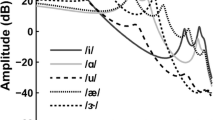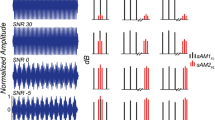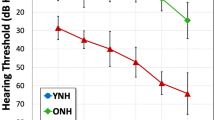Abstract
Vowel-evoked envelope following responses (EFRs) reflect neural encoding of the fundamental frequency of voice (f0). Accurate analysis of EFRs elicited by natural vowels requires the use of methods like the Fourier analyzer (FA) to consider the production-related f0 changes. The FA’s accuracy in estimating EFRs is, however, dependent on the assumed neurophysiological processing delay needed to time-align the f0 time course and the recorded electroencephalogram (EEG). For male-spoken vowels (f0 ~ 100 Hz), a constant 10-ms delay correction is often assumed. Since processing delays vary with stimulus and physiological factors, we quantified (i) the delay-related variability that would occur in EFR estimation, and (ii) the influence of stimulus frequency, non-f0 related neural activity, and the listener’s age on such variability. EFRs were elicited by the low-frequency first formant, and mid-frequency second and higher formants of /u/, /a/, and /i/ in young adults and 6- to 17-year-old children. To time-align with the f0 time course, EEG was shifted by delays between 5 and 25 ms to encompass plausible response latencies. The delay-dependent range in EFR amplitude did not vary by stimulus frequency or age and was significantly smaller when interference from low-frequency activity was reduced. On average, the delay-dependent range was < 22% of the maximum variability in EFR amplitude that could be expected by noise. Results suggest that using a constant EEG delay correction in FA analysis does not substantially alter EFR amplitude estimation. In the present study, the lack of substantial variability was likely facilitated by using vowels with small f0 ranges.







Similar content being viewed by others
Data Availability
Available upon request to the authors.
References
Aiken SJ, Picton TW (2006) Envelope following responses to natural vowels. Audiology and Neurotology 11:213–232. https://doi.org/10.1159/000092589
Alaerts J, Luts H, van Dun B et al (2010) Latencies of auditory steady-state responses recorded in early infancy. Audiology and Neurotology 15:116–127. https://doi.org/10.1159/000231637
Benjamini Y, Hochberg Y (1995) Controlling the false discovery rate: a practical and powerful approach to multiple testing. J R Stat Soc Series B Stat Methodol 57(1):289–300
Bidelman GM (2018) Subcortical sources dominate the neuroelectric auditory frequency-following response to speech. Neuroimage 175:56–69. https://doi.org/10.1016/j.neuroimage.2018.03.060
Bruce IC, Erfani Y, Zilany MSA (2018) A phenomenological model of the synapse between the inner hair cell and auditory nerve: implications of limited neurotransmitter release sites. Hearing Res 360:40–54. https://doi.org/10.1016/j.heares.2017.12.016
Canneyt JV, Wouters J, Francart T (2021) Neural tracking of the fundamental frequency of the voice: the effect of voice characteristics. Eur J Neurosci 53:3640–3653. https://doi.org/10.1111/ejn.15229
Choi JM, Purcell DW, Coyne J-AM, Aiken SJ (2013) Envelope following responses elicited by english sentences. Ear Hear 34:637–650. https://doi.org/10.1097/aud.0b013e31828e4dad
Coffey EBJ, Herholz SC, Chepesiuk AMP et al (2016) Cortical contributions to the auditory frequency-following response revealed by MEG. Nat Commun 7:11070. https://doi.org/10.1038/ncomms11070
Cohen LT, Rickards FW, Clark GM (1991) A comparison of steady-state evoked potentials to modulated tones in awake and sleeping humans. J Acoust Soc Am 90:2467–2479
Draganova R, Ross B, Borgmann C, Pantev C (2002) Auditory cortical response patterns to multiple rhythms of AM sound. Ear Hear 23:254–265
Easwar V, Birstler J, Harrison A et al (2020) The accuracy of envelope following responses in predicting speech audibility. Ear Hear 41:1732–1746. https://doi.org/10.1097/aud.0000000000000892
Easwar V, Bridgwater E, Purcell D (2021a) The influence of vowel identity, vowel production variability, and consonant environment on envelope following responses. Ear Hear 42:662–672. https://doi.org/10.1097/aud.0000000000000966
Easwar V, Purcell DW, Aiken SJ et al (2015a) Effect of stimulus level and bandwidth on speech-evoked envelope following responses in adults with normal hearing. Ear Hear 36:619–634. https://doi.org/10.1097/aud.0000000000000188
Easwar V, Purcell DW, Aiken SJ et al (2015b) Evaluation of speech-evoked envelope following responses as an objective aided outcome measure: effect of stimulus level, bandwidth, and amplification in adults with hearing loss. Ear Hear 36:635–652. https://doi.org/10.1097/aud.0000000000000199
Easwar V, Scollie S, Lasarev M et al (2021b) Characteristics of speech-evoked envelope following responses in infancy. Trends Hear 25:233121652110043. https://doi.org/10.1177/23312165211004331
Easwar V, Scollie SD, Purcell DW (2019) Investigating potential interactions between envelope following responses elicited simultaneously by different vowel formants. Hear Res 380:35–45. https://doi.org/10.1016/j.heares.2019.05.005
Goodman SS (2017) Auditory research lab audio software. Github, Iowa City. Retrieved from http://github.com/myKungFu/ARLas
John SM, Picton TW (2000) Human auditory steady-state responses to amplitude-modulated tones: phase and latency measurements. Hear Res 141:57–79. https://doi.org/10.1016/s0378-5955(99)00209-9
Martin BA, Boothroyd A (2000) Cortical, auditory, evoked potentials in response to changes of spectrum and amplitude. J Acoust Soc Am 107:2155–2161
Martin BA, Tremblay KL, Korczak P (2008) Speech evoked potentials: from the laboratory to the clinic. Ear Hear 29:285–313. https://doi.org/10.1097/aud.0b013e3181662c0e
Picton TW, John SM, Dimitrijevic A, Purcell DW (2003) Human auditory steady-state responses. Int J Audiol 42:177–219
Purcell DW, John SM, Schneider BA, Picton TW (2004) Human temporal auditory acuity as assessed by envelope following responses. J Acoust Soc Am 116:3581–3593. https://doi.org/10.1121/1.1798354
Ross B, Tremblay KL, Alain C (2020) Simultaneous EEG and MEG recordings reveal vocal pitch elicited cortical gamma oscillations in young and older adults. Neuroimage 204. https://doi.org/10.1016/j.neuroimage.2019.116253
R Core Team (2021) R: A language and environment for statistical computing. R Foundation for statistical computing, Vienna, Austra. https://www.R-project.org/.
Skoe E, Kraus N (2010) Auditory brain stem response to complex sounds: a tutorial. Ear Hear 31:302–324. https://doi.org/10.1097/aud.0b013e3181cdb272
Skoe E, Krizman J, Anderson S, Kraus N (2015) Stability and plasticity of auditory brainstem function across the lifespan. Cereb Cortex 25:1415–1426. https://doi.org/10.1093/cercor/bht311
Tichko P, Skoe E (2017) Frequency-dependent fine structure in the frequency-following response: the byproduct of multiple generators. Hear Res 348:1–15. https://doi.org/10.1016/j.heares.2017.01.014
Vanheusden FJ, Bell SL, Chesnaye MA, Simpson DM (2019) Improved detection of vowel envelope frequency following responses using Hotelling’s T2 analysis. Ear Hear 40:116–127. https://doi.org/10.1097/aud.0000000000000598
Wang L, Bharadwaj H, Shinn-Cunningham B (2019) Assessing cochlear-place specific temporal coding using multi-band complex tones to measure envelope-following responses. Neuroscience 407:67–74. https://doi.org/10.1016/j.neuroscience.2019.02.003
Funding
This study was funded in part by a Collaborative Health Research Project grant from the Canadian Institutes of Health Research and the Natural Sciences and Engineering Research Council of Canada (grant #493836–2016; Western University), and the Hearing Health Foundation (Emerging Research grant; University of Wisconsin-Madison).
Author information
Authors and Affiliations
Contributions
VE: designed the study, provided ethics and grant oversight at University of Wisconsin-Madison, analyzed data, and wrote the manuscript; KB, EM & MG: collected data, reviewed the manuscript; SA: modelled cochlear delays in stimulus, reviewed the manuscript; SS: provided ethics and grant oversight at Western University, reviewed the manuscript; DP: designed the study, analyzed data and model, and edited the manuscript.
Corresponding author
Ethics declarations
Conflict of Interest
The authors declare no competing interests.
Additional information
Publisher's Note
Springer Nature remains neutral with regard to jurisdictional claims in published maps and institutional affiliations.
Majority of the work was completed when at the University of Wisconsin-Madison.
Rights and permissions
About this article
Cite this article
Easwar, V., Aiken, S., Beh, K. et al. Variability in the Estimated Amplitude of Vowel-Evoked Envelope Following Responses Caused by Assumed Neurophysiologic Processing Delays. JARO 23, 759–769 (2022). https://doi.org/10.1007/s10162-022-00855-1
Received:
Accepted:
Published:
Issue Date:
DOI: https://doi.org/10.1007/s10162-022-00855-1




